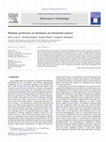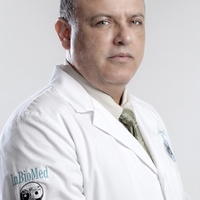Papers by Ibrahim Ibrahim

Non-communicable diseases have now become a serious threat to global health, including diabetes. ... more Non-communicable diseases have now become a serious threat to global health, including diabetes. in reports from Sungai Geringging Public Health Center in 2020 the prevalence of diabetes mellitus was 450 people. Checking blood sugar levels in diabetic patients should be done regularly. Examination of blood glucose levels using the glucose oxidase method, examination materials in the form of venous blood and capillary blood. This study aims to determine the comparison of glucose levels in capillary and venous blood using a glucometer in patients with diabetes mellitus. This type of quantitative research was carried out at Sungai Geringging Public Health Center, Padang Pariaman Regency, and carried out in February 2021. The population of patients who did blood glucose checks with a sample of 81 people. Data analysis was univariate and bivariate using a t-test. The results of capillary blood glucose levels were 203.507 mg/dl, glucose levels in venous blood were 199.753 mg/dl. There is ...

Expert Review of Clinical Immunology, 2012
Background Rheumatoid arthritis (RA) is a chronic, systemic, autoimmune disease that is character... more Background Rheumatoid arthritis (RA) is a chronic, systemic, autoimmune disease that is characterized by inflammation of the synovium. In its active form, RA leads to swelling, tenderness and the progressive destruction of joints. Treatment in the first instance is focused around the use of steroids and disease-modifying anti rheumatic drugs (DMARDs), such as methotrexate (MTX). More recently, biological therapies that block the TNF pathway (anti-TNF drugs) have emerged as more effective, especially in cases where RA is refractory to treatment with DMARDs [1]. Such biological therapies have been shown to slow disease progression, reduce inflammation and improve symptoms, but are much more expensive (~£8000–10,000 per patient per year) compared with MTX (~£35 per patient per year) [2,101]. There is also a significant nonresponse rate to both drugs: MTX 45% and anti-TNF 23% by 48 weeks [3,4]. Furthermore, both drugs are also associated with serious adverse events (AEs); for example, MTX is associated with hepatotoxicity and pneumonitis, while anti-TNF drugs increase the risk of serious infections. However, the introduction of early, effective therapy has consistently been shown to improve the long-term outcomes of RA including joint damage, disability and employment [5–7]. Thus, achieving the right treatment in the first instance is essential in order to deliver improved and more cost-effective outcomes for patients with RA, a goal that would no doubt be facilitated by the identification of predictors of treatment response. Past Some predictors for response to each drug have already been identified. For example, baseline disability (assessed by the health assessment questionnaire), concurrent DMARD therapy, gender, rheumatoid factor and anti-cyclic citrullinated peptide antibody status all correlate with response to anti-TNF drugs and, together, account for approximately 17% of the variability of response [8]. However, this is not sufficiently predictive to be of use in clinical practice, and recent years have seen a significant focus being placed on the identification of genetic and genomic predictors [9]. The actions of many drugs are determined by their effect on particular genes and biological pathways, and this is where genetic variants would make ideal biomarkers of response, as they are stable, easily measured and inexpensive to assess.

Journal of Agricultural and Food Chemistry, 2004
DNA isolation from plants is sometimes difficult due to the existence of high levels of endogenou... more DNA isolation from plants is sometimes difficult due to the existence of high levels of endogenous phenolics, polysaccharides, or other substances that may interfere with DNA extraction. Theobroma cacao produces high levels of anthocyanins in young leaves. These plant polyphenols can interfere with DNA isolation. After examination of various procedures for DNA isolation, two commercial isolation procedures have proved to be repeatedly successful using these types of plants, the D 2 BioTechnologies DNA X-tract Plus kit and the Qiagen DNeasy Plant System DNA kit. These commercial kits were chosen for their speed and ease over the CTAB procedure, which is more labor intensive. All protocols assessed yielded DNA suitable for AFLP or SSR procedures. An additional factor in DNA extraction efficiency is the degree of cell breakage, which may be more difficult with the highly fibrous leaf tissue that is found in many monocots, including date palm. Two commercially produced pieces of equipment were tested and, for cacao, both resulted in template DNA yielding amplification product in AFLP or SSR fingerprinting. However, for the fibrous date palm leaf, the larger FastPrep homogenizer consistently yielded DNA that generated higher signals when amplified than did the smaller Disruptor Genie.

Clinical Neurology and Neurosurgery, 2008
To analyze the impact of the lunar cycle and season on the incidence of aneurysmal subarachnoid h... more To analyze the impact of the lunar cycle and season on the incidence of aneurysmal subarachnoid hemorrhage (SAH). The medical records of 111 patients who were admitted over a 5-year period to our department because of aneurysmal SAH were retrospectively reviewed. The date of aneurysm rupture was matched with the corresponding season and moon phase. An incidence peak for aneurysm rupture (28 patients) was seen during the phase of new moon, which was statistically significant (p < 0.001). In contrast, no seasonal variation in the incidence of SAH was observed. The lunar cycle seems to affect the incidence of intracranial aneurysm rupture, with the new moon being associated with an increased risk of aneurysmal SAH.

Bioresource Technology, 2012
Over 9 million dairy cows generate an estimated 226 billion kg of wet manure annually in the US. ... more Over 9 million dairy cows generate an estimated 226 billion kg of wet manure annually in the US. The purpose of this study was to demonstrate the viability of a novel two-stage anaerobic digestion (AD) process for producing methane-rich biogas on pre-fermented dairy manure. In summary, it was observed that AD of thickened pre-fermented manure can generate comparable biogas quantities to AD using raw manure, with enhanced methane content. Despite receiving a lower quality (i.e., partially biodegraded) substrate, biogas stoichiometry and overall process stability in the two-stage system was also comparable to AD receiving raw manure. Finally, the two-stage AD was more enriched with the acetoclastic methanogen Methanosarcinaceae (Msc; compared to AD of raw manure) and biogas production appeared closely linked with the Msc fraction. In fact, the enhanced enrichment of Msc likely contributed to the successful and stable operations.

AFRICAN JOURNAL OF BIOTECHNOLOGY, 2012
Textile wastewater (TWW) causes many environmental problems, and colored substances must be remov... more Textile wastewater (TWW) causes many environmental problems, and colored substances must be removed from it before their discharge into the environment. An optimization process was analyzed using custom response surface methodology (RSM). In the present study, the effect of different combinations of eight strains was studied using equilateral triangle diagram (Minitab 14.0) and mixture experimental design to assess color and chemical oxygen demand (COD) removal during the growth of species. Under optimal conditions, the bacterial consortium developed was able to decolorize completely (>84%) the dye within 72 h. The color and COD removal were 89.97 and 84.71%, respectively. A significant increase in azoreductase, lignin peroxidase and laccase activities in the cells were obtained after complete decolorization. Ultraviolet (UV)-vis and nuclear magnetic resonance (NMR) spectroscopy analysis confirmed the biodegradability of the TWW by the developed bacterial consortium.











Uploads
Papers by Ibrahim Ibrahim